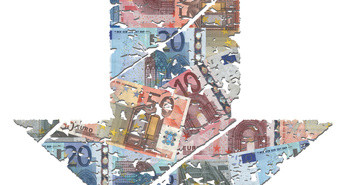By Alex Edwards at UKForex, an international money transfer service
The euro was whacked lower this week, as expectations grew for the ECB to take action to stave off the threat of deflation at their monetary policy meeting next week. This comes after two successive meetings in which they essentially sat on their hands. Various comments by ECB officials throughout the week have fuelled such investor expectations – for instance, ECB member Weidmann said that quantitative easing couldn’t be ruled out and negative interest rates were still an option, given the impact of the high value of the euro on inflation. Data hasn’t helped either: German PMIs, German IFO Business Climate and Spanish CPI all printed weaker than forecasts last week, and weighed on the single currency.
The threat of action by the ECB will likely continue weighing on the euro in the run-up to Thursday’s announcement. The risk, however, is that Mario Draghi does not act, again, and the ECB continues to take a ‘wait and see’ approach. Therefore, while we expect EUR/USD to come under pressure in the days preceding the announcement, there is potential for a bounce back in EUR/USD later in the week as investors ‘buy the fact’.
Conversely, GBP made good gains. UK CPI for February, released earlier in the week, fell to 1.7% y/y. Heading in to the release, there were growing concerns that the data would print weaker than 1.7% , given the heavy discounting by UK retailers last month. Even though inflation data recorded the lowest reading in 4 years, we witnessed what might be described as a mild ‘relief’ bounce in cable and it pushed back above 1.65. The pair was also better bid following comments from the BoE’s Weale, published in a local newspaper: Weale commented that interest rates won’t stay at 0.5% forever.
Furthermore, UK retail sales data smashed investor expectations on Thursday morning, largely a result of better sales in both food and non-food stores. GBP/USD gapped higher through 1.66 and on to a high of 1.6640, as the data showed that consumers on the high street are feeling more confident about the UK’s recovery. It is data like this that will fuel expectations for a rate hike from the Bank of England come early 2015. If PMIs beat forecasts next week, those rate hike expectations may well be brought forward.                                                                                                       Â
This has meant that this week has been a mixed bag for the USD. Data was indifferent last week whilst investors are still reeling from the FOMC statement a week earlier. In other news, commodity currencies, including AUD and NZD, have had strong weeks. RBA Governor Stevens said on Tuesday that he expected a period of stability in interest rates as well as low inflation risks. He also commented that a lower AUD would help the economy, but against the expectations of some market commentators, he did not aggressively jaw-bone the currency lower.
NZ trade data, too, came in much better than market forecasts, with the surplus for February printing at $818mio vs. expectations for $600mio. RBNZ Deputy Governor Spencer was on the wires from Hong Kong on the same day, saying that following the earthquake, the rebuild in Christchurch was adding to the country’s inflation risk. This, in turn, is fuelling expectations for more rate hikes from the RBNZ in the near future.
The focus next week will be on what the ECB does – or does not do. Meanwhile, Yellen is due to speak on Monday, and the markets will be hoping for more clarity on when the first rate hike will come. UK PMIs are also due whilst US Non-Farm Payrolls – a lottery number – is due on Friday.
Further reading:Â 5 most predictable currency pairs



